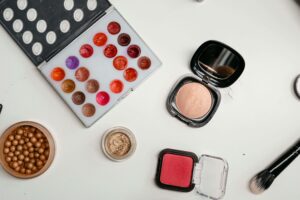Blush Basics

Blush is like the magic wand of makeup – with just a sweep of color, it can instantly brighten your complexion, add warmth to your face, and give you that coveted healthy glow. However, finding the perfect blush shade for your skin tone can be a daunting task amidst the sea of options available. Fear not! In this comprehensive guide, we’ll break down the blush basics, from understanding your skin tone to choosing the right shade and mastering the art of application, so you can blush like a pro and enhance your natural beauty effortlessly.
Understanding Your Skin Tone
Before diving into the world of blush, it’s essential to understand your skin tone. Generally, skin tones fall into three categories: warm, cool, and neutral. Here’s how to determine yours:
- Warm Undertones: If your skin has a yellow, peachy, or golden hue and you look best in earthy tones like red, orange, and yellow, you likely have warm undertones.
- Cool Undertones: If your skin has a pink, rosy, or blue undertone and you look best in jewel tones like blue, purple, and emerald green, you likely have cool undertones.
- Neutral Undertones: If your skin has a balanced mix of warm and cool undertones, making it difficult to determine whether you lean more towards warm or cool tones, you likely have neutral undertones.
Determining your skin tone is crucial when choosing blush shades, as certain colors complement different undertones better than others.
Choosing the Right Blush Shade
Now that you’ve identified your skin tone, it’s time to select the perfect blush shade to enhance your natural beauty:
- For Warm Undertones: Opt for peachy, coral, or warm pink blush shades with hints of orange or gold. These colors will complement your warm undertones and add a sun-kissed glow to your complexion. Avoid cool-toned pinks and purples, as they can clash with your warm skin tone.
- For Cool Undertones: Reach for rosy, berry, or cool pink blush shades with blue or purple undertones. These colors will complement your cool undertones and create a fresh, youthful look. Steer clear of warm-toned oranges and browns, as they can appear harsh against your cool skin tone.
- For Neutral Undertones: Lucky you! With neutral undertones, you can rock a wide range of blush shades, from soft peaches to rosy pinks to mauves. Experiment with different colors to see what complements your skin tone best and adds a natural flush to your cheeks.
When choosing a blush shade, consider the intensity of the color as well. Fair skin tones may prefer lighter, more subtle shades, while deeper skin tones can pull off richer, more pigmented colors.
Mastering Blush Application
Now that you’ve found the perfect blush shade for your skin tone, it’s time to master the art of application:
- Prep Your Skin: Start with a clean, moisturized canvas. Apply your foundation and concealer as usual, ensuring a smooth and even base for your blush.
- Choose the Right Tools: Opt for a fluffy blush brush or a stippling brush for a seamless application. Tap off any excess product before applying to avoid overloading your cheeks with color.
- Find Your Cheekbones: Smile gently to locate the apples of your cheeks. Using light, sweeping motions, apply the blush to the apples of your cheeks and blend upwards towards your temples for a natural-looking flush.
- Blend, Blend, Blend: Blending is key to achieving a seamless finish. Use a clean brush or a makeup sponge to blend out any harsh lines and ensure a soft, diffused look.
- Build Gradually: Start with a light layer of blush and build up the intensity gradually until you achieve your desired look. It’s easier to add more blush than to remove excess product, so err on the side of caution.
- Finish with Setting Powder: Once you’re happy with your blush placement, lightly dust your cheeks with a translucent setting powder to lock the color in place and prevent any unwanted shine.

Blush Tips and Tricks
- Cream vs. Powder: Cream blushes offer a natural, dewy finish and are ideal for dry or mature skin types, while powder blushes provide long-lasting wear and are great for oily or combination skin types.
- Multi-Tasking Products: Some blushes can double as eyeshadows or lip colors. Experiment with different application techniques to make the most of your blush palette.
- Try a Pop of Color: Don’t be afraid to experiment with bold or unconventional blush shades like tangerine, fuchsia, or even plum. A pop of color can add a fun and unexpected twist to your makeup look.
- Blush Placement: Adjust your blush placement based on your face shape. For round faces, focus on the apples of the cheeks and blend upwards towards the temples. For long faces, apply blush horizontally across the apples of the cheeks to create width.
With the right blush shade and application techniques, you can enhance your natural beauty and achieve a radiant, healthy-looking complexion. Whether you prefer a subtle flush or a bold pop of color, blush is the perfect finishing touch to any makeup look. So go ahead, embrace your inner glow, and blush with confidence!

